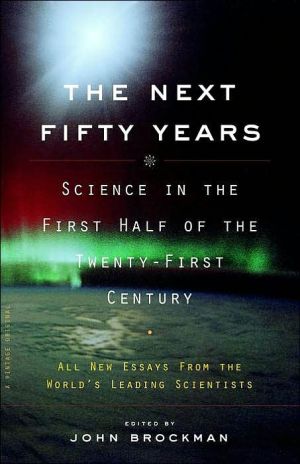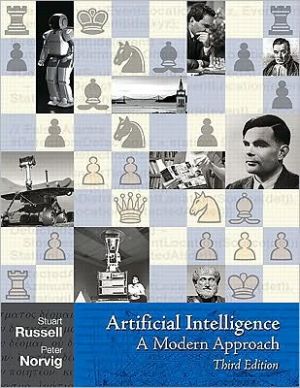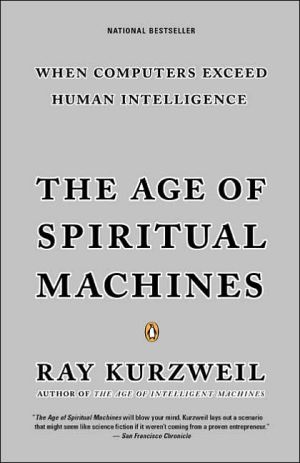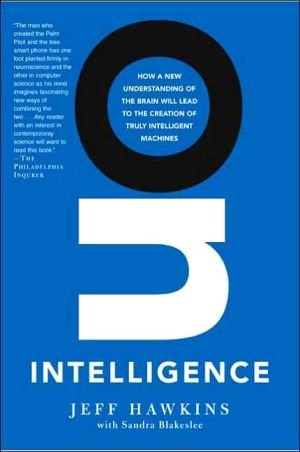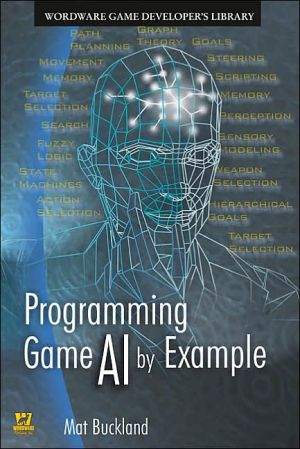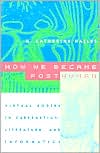The Next Fifty Years: Science in the First Half of the Twenty-First Century
A brilliant ensemble of the world’s most visionary scientists provides twenty-five original never-before-published essays about the advances in science and technology that we may see within our lifetimes.\ Theoretical physicist and bestselling author Paul Davies examines the likelihood that by the year 2050 we will be able to establish a continuing human presence on Mars. Psychologist Mihaly Csikszentmihalyi investigates the ramifications of engineering high-IQ, geneticially happy babies....
Search in google:
A brilliant ensemble of the world’s most visionary scientists provides twenty-five original never-before-published essays about the advances in science and technology that we may see within our lifetimes.Theoretical physicist and bestselling author Paul Davies examines the likelihood that by the year 2050 we will be able to establish a continuing human presence on Mars. Psychologist Mihaly Csikszentmihalyi investigates the ramifications of engineering high-IQ, geneticially happy babies. Psychiatrist Nancy Etcoff explains current research into the creation of emotion-sensing jewelry that could gauge our moods and tell us when to take an anti-depressant pill. And evolutionary biologist Richard Dawkins explores the probability that we will soon be able to obtain a genome printout that predicts our natural end for the same cost as a chest x-ray. (Will we want to read it? And will insurance companies and governments have access to it?) This fascinating and unprecedented book explores not only the practical possibilities of the near future, but also the social and political ramifications of the developments of the strange new world to come.Also includes original essays by:Lee Smolin Martin Rees Ian Stewart Brian Goodwin Marc D. Hauser Alison Gopnik Paul Bloom Geoffrey Miller Robert M. Sapolsky Steven Strogatz Stuart Kauffman John H. Holland Rodney Brooks Peter Atkins Roger C. Schank Jaron Lanier David Gelernter Joseph LeDoux Judith Rich Harris Samuel Barondes Paul W. Ewald Publishers Weekly Agent Brockman has collected 25 of his writers to discuss the future of science in their respective fields of study. Several of these writers surpass ordinary trend spotting to entertain some rather pulse-quickening ideas completely beyond the kin of the so-called dominant paradigm. And some are of a magnitude to radically advance the nature of humans' interaction with each other, the planet and beyond. The neurologist Robert Sapolsky, for example, posits that sadness will take its place alongside AIDS and Alzheimer's as the most notorious medical disasters of the next half-century. Brockman, who is also an author-editor (The Third Culture; The Greatest Inventions of the Past 2,000 Years, etc.), divides his collection into two parts: the future in theory and the future in practice. Theoretical topics include cosmology, what it means to be alive, the nature of consciousness and the possibility of extraterrestrial intelligence. Mars exploration, DNA sequencing, neuroscience, child rearing and the like are addressed in the practical half. These essays can be quite technical, intended as they are to make the latest scientific information available for cross-disciplinary research. The intellectual adventures collected here point to a future that is dazzlingly bright, at least to the eyes of these unorthodox thinkers. The general public, for whom these essays are also written, should be similarly bedazzled. (May 21) Copyright 2002 Cahners Business Information.
Part One\ The Future,\ In Theory\ Lee Smolin\ The Future of the Nature\ of the Universe\ We are asked to predict the state of our science fifty years from today. Fifty years is a long time, given the pace at which physics and cosmology have progressed over the last several hundred years. But perhaps it is not too long a time to make predictions that will not seem entirely stupid by then. If you look back over the history of science, you will see that often the important questions people were asking had been answered fifty years later. And yet the progress of science has usually been slow enough that people speak roughly the same language as their colleagues working in the same field fifty years earlier.\ Let's look back fifty years, then, and note what the big questions were. My own list would include:\ 1)What is the nature of the strong force that holds atomic nuclei together?\ 2)What is the nature of the weak force responsible for radioactive decay?\ 3)Is the Steady State model of the universe right, or might there have been a Big Bang, as speculated by Gamow and other fringe figures?\ 4)Do protons and neutrons have any internal structure?\ 5)Why do the proton and neutron have slightly different masses, while the electron is much lighter than either? Why is the neutrino massless? What is the muon and who ordered it?\ 6)What is the relationship between general relativity and quantum theory?\ 7)What is the right way to understand the quantum theory?\ I think we can confidently assert that now we know the answers to the first four questions. We are still working on the last three. But the first have not been forgotten; indeed, the methods by which those questions were answered form the basis of the training of a theoretical physicist today.\ If we look back a hundred years, however, we find that we no longer care about many of the questions people were asking then. I'm not enough of a historian to write a list of questions asked by physicists at the turn of the last century, but they would likely have been more concerned with the properties of the ether than with the properties of atoms. There was no evidence for the existence of physical atoms until a few years later--and, indeed, in 1900 many physicists did not believe that atoms existed. Others, like Ernst Mach, thought the question was not a part of physics because atoms would never be observed. As for astronomy, there was no evidence in 1900 for the existence of galaxies apart from our own Milky Way, nor did anyone have any idea what made the stars shine. So while physicists of the early 1950s would probably have understood the questions that physicists are asking now, no one at the beginning of the twentieth century could have understood even the words that physicists were using in 1950 to talk to each other.\ Sometimes science changes so little over fifty years that it makes sense to try to predict what we will know after that span. But there are periods when progress is faster and this is no longer the case. It seems that there is a horizon, somewhere between fifty and a hundred years into the future, beyond which it may be useless to speculate in any detail about the progress of science.\ Let's take a moment to consider why this is so. It's probably partly because fifty years is about the length of a scientific career, from the beginning of studies until retirement. This, then, is the span of time over which the conservative tendencies built into the structure of scientific careers act to retard the progress of science. Science is hard, and we scientists prefer to have as good an understanding of what we're doing as possible; thus, unless forced to do otherwise, we prefer to work with techniques and ideas we already understand well. Another factor is that the careers of young scientists are often controlled by senior people nearing retirement, who are in many cases no longer active and therefore unfamiliar with new techniques. Career-savvy graduate students, no matter how imaginative, hesitate to work on something not understood by the powerful old men and women of their field. Thus, in order to think about what my science will be like in fifty years, I imagine what the brightest of my graduate students will be talking about at their retirement parties. My guess is that unless they are forced by data they cannot otherwise explain to make a revolution comparable to that of the early twentieth century, they will be using the language we've taught them. If that's the case, the present exercise may be useful--though the romantics among us would rather anticipate a revolution than confirmation of our own beliefs.\ One can also speculate on what was different about the sociology of science in the first half of the twentieth century to enable such enormous progress. Two credible answers come to mind: One is that it was possible for outsiders, such as Albert Einstein and Paul Ehrenfest, to publish in spite of not having university positions; another is that the generation that preceded the inventors of quantum theory was mostly wiped out in World War I, leaving the field open for Heisenberg, Dirac, and their friends.\ This said, what will we know about fundamental physics and cosmology in fifty years? Rather than guessing, I propose a method that has a chance of reaching conclusions that won't look silly in the 2050s. I will list the most fundamental questions that are currently unanswered. Then I will ask what developments we may expect in experimental and observational science which will enable answers to them to be checked. I won't worry about theoretical developments, since there are already proposed answers to all of my questions and I assume that over a time span of fifty years we theorists will be able to adjust our theories, or invent new ones, in response to the data.\ Here, then, is my list of the seven most important open questions in fundamental physics and cosmology:\ 1)Is quantum theory true as presently formulated, or will it need to be modified, either to have a sensible physical interpretation or to unify it with relativity and cosmology?\ 2)What is the quantum theory of gravity? What is the structure of space and time on the Planck scale (10-33 cm, or twenty orders of magnitude smaller than an atomic nucleus)?\ 3)What explains the exact values of the parameters that determine the properties of the elementary particles, including their masses and the strengths of the forces by which they interact?\ 4)What explains the large ratios of scales we observe? Why is the gravitational force between two protons forty powers of ten smaller than their electrical repulsion? Why is the universe so big? Why is it at least sixty powers of ten bigger than the fundamental Planck scale? Why is the cosmological constant smaller than any other parameter in physics by roughly the same ratio?\ 5)What was the Big Bang? What determined the properties of the universe that emerged from it? Was the Big Bang the origin of the universe? If not, what happened before it?\ 6)What constitutes the dark matter and dark energy that make up between 80 and 95 percent of the density of the universe?\ 7)How did the galaxies form? What do the patterns we observe in the distribution of the galaxies tell us about the early evolution of the universe?\ The first four of these questions continue, and deepen, unanswered questions from fifty years ago. The other three are new. Let us then ask whether the observations and experiments we'll be able to make in 2050 will be sufficient to test answers that theorists may propose to these questions. Of course, anything could be invented in fifty years. If my method is to be believable, we have to be conservative about the development of technology. I will thus consider only technology already existing or under development. In the latter case, I will consider only technology that a sizable fraction of experts believe will work in the next few years. However, for each technology existing or under development, I will assume that over the course of fifty years it will have been developed as far as possible, given only constraints imposed by the laws of physics or economics. Ordinary microscopes have a natural limit given by the wavelength of light, while telescopes have a natural limit imposed by the speed of light in a universe of finite age. Other technologies are more likely to be limited by financial considerations. We can safely assume that no experiment will be done whose cost (at that time) exceeds the defense budget of the United States. Let me hasten to add that I am not an expert in experimental physics or observational cosmology and I have not done a careful study of the limits involved. So my estimates will of necessity be very broad. Based on an extrapolation of current technology to its natural and financial limits, here is what I think we may hope for by mid-century.\ We may begin with quantum theory. At present, powerful new techniques are being developed that promise to greatly extend the regime over which the quantum theory has been experimentally tested--techniques chiefly in aid of developing quantum computers. These are macroscopic devices that use quantum effects, such as superposition and entanglement, to do computations impossible for ordinary computers. A quantum computer requires those effects--which have so far been observed only for atomic systems--to work for macroscopic systems like the circuits of a computer, so the devices test those predictions of quantum theory that differ most strongly from classical theory.\ Because it has been demonstrated that quantum computers could break all the codes now used by governments, militaries, and business, a lot of money is going into quantum computing. So it is safe to assume that as long as quantum mechanics remains true when extrapolated to macroscopic systems, there will be quantum computers in fifty years, and there are also likely to be quantum communication devices that make use of quantum states extending nonlocally worldwide. And if the present quantum theory is only an approximation of a deeper theory, experiments with quantum computers are likely to reveal this. It is thus reasonable to conclude that fifty years from now we will know the answer to the first question.\ Let's turn next to cosmology. By mid-century we will certainly have a detailed picture of the history of the universe, based on observations using the full range of the electromagnetic spectrum, plus neutrinos, cosmic rays, and gravitational waves. The parameters in our current cosmological models will have been measured to high precision, and we will know lots of other facts about the universe, such as the number of black holes, the distributions in space and time of stars, galaxies, black holes, neutron stars, quasars, gamma ray bursters, and other objects. In fact, we will probably know more about the detailed history and properties of the universe than we know now about the history of the surface of our planet. At least in terms of familiarity with the whole range of its phenomena, we will truly be "at home in the universe."\ The results will strongly constrain current theories of the early universe, such as inflation. We will also have a detailed picture of how galaxies and the patterns of galactic clusters and superclusters formed. Even without direct observations of dark matter, those observations will strongly constrain theories of the nature of dark matter and dark energy. By mid-century we may or may not have directly observed dark matter and dark energy and learned enough about them to confirm or refute the various theories that have been proposed about them.\ Some readers will ask whether all these observations might confirm the Big Bang theory. To answer that question, we must distinguish between two meanings of Big Bang cosmology. I'll call the first the Expanding Universe cosmology: This is the theory that the universe has expanded from a much denser and hotter state for roughly 13 billion years. Among the key events in this story is the decoupling of light and matter when the universe had cooled enough for atoms to be stable. For roughly a million years before that, the universe was filled with a plasma, like the interior of a star. Since the transition, the universe has been filled with a very dilute gas, transparent to light, and all of the structures we see--stars and their planets, galaxies, galactic clusters--were formed. And almost all the chemical elements were formed since the transition, in stars; only helium and other light elements, like deuterium and lithium, were formed beforehand. I think it is unlikely that the outline of this story will be modified fifty years from now. We will know much more about the processes whereby stars, galaxies, and the elements formed, but all the evidence will still support the Expanding Universe theory.\ It is also safe to say that we will have observations that strongly constrain our theories about what happened in the very early history of the universe. As we turn back the clock, the density and temperature increase. It is interesting to wonder how far back we can go to constrain theories by observation. By mid-century the part of the theory open to test is likely to extend back at least to the Planck time, a period so small that 1043 of them would fit into one second. Take, for example, the inflation hypothesis. Under a certain set of reasonable assumptions, predictions of this theory are testable in current observations of the fluctuations in the cosmic microwave background. These observations make up one of the greatest achievements of recent science. But even if current observations are compatible with inflation, there remain many open questions: The predictions of inflation are simple and may well be implied by other theories, so measurements that are more detailed may be needed to distinguish inflation from possible rival explanations of the present data. Moreover, there are many different versions of inflation, and further measurements are certainly needed to distinguish them. We hope to have those more detailed measurements of the cosmic microwave background not in fifty years but in five. So it is reasonable, if not certain, to predict that by mid-century it will be old hat to consider theories of the expanding universe testable by detailed observations all the way back from our present era to the Planck time.\ But the Planck time is still not the origin of time. Very different from the Expanding Universe theory is the assertion that the Big Bang was the absolute beginning of the universe. Even if we know that the universe is hotter and denser all the way back to some point that may be a fraction of a second after some theoretical beginning, this does not prove that something didn't happen before that to set the expansion in motion. So it remains possible that the universe existed, possibly in some different form, a long time before the moment of the theoretical "Big Bang." To distinguish these kinds of hypotheses, let me refer to them as Origin of the Universe theories.
Introduction: by John Brockman###Part I: The Future, in Theory###[p.xx]Lee Smolin: The Future of the Nature of the Universe"We will probably know more about the detailed history and properties of the universe than we know now about the history of the surface of our planet."###[p. xx]Martin Rees: Cosmological Challenges: Are We Alone, and Where?"We can't predict what role life will eventually carve out for itself: It could become extinct, or it could achieve such dominance that it would influence the entire cosmos."###[p. xx]Ian Stewart: The Mathematics of 2050"There will be 'virtual unreality' systems, allowing mathematicians to 'visit' abstract conceptual structures such as non-euclidean geometries or ranges of giant primes and manipulate them at will." ###[p. xx]Brian Goodwin: In the Shadow of Culture"Why is animism so threatening to the Western scientific worldview? Is there any sign that the dialectic of science is beginning to bring this view into the light again?"###[p. xx]Marc D. Hauser: Swappable Minds"Imagine that we could download the neuronal signals from any animal, creating a kind of hard-drive library of their thoughts while they were interacting with the world."###[p. xx]Alison Gopnik: What Children Will Teach Scientists"The greatest achievement of a unified theory of learning may be to demonstrate that the most brilliant scientists and the most ordinary kids are engaged in the same enterprise."###[p. xx]Paul Bloom: Toward a Theory of Moral Development"It may be that the nature of moral thought or consciousness is simply beyond our understanding, not because they have a special, mystical status but because we aren't smart enough to understand such things. We might be like dogs trying to understand calculus." ###[p. xx]Geoffrey Miller: The Science of Subtlety"Our more recently evolved, distinctively human capacities—for creativity, kindness, humor, imagination—remain understudied in brain-imaging labs."###[p. xx]Mihaly Csikszentmihalyi: The Future of Happiness"In the past, we were like passengers on the slow coach of evolution. Now evolution is more like a rocket hurtling through space, and we are no longer passengers but its pilots."###[p. xx]Robert M. Sapolsky: Will We Still Be Sad Fifty Years from Now?"Our technology isn't likely to help reduce our stress, despite (or maybe even because of) our expectation that it will."###[p. xx]Steven Strogatz: Fermi's "Little Discovery" and the Future of Chaos and Complexity Theory"Nonlinearity giveth chaos, and nonlinearity taketh it away."###[p. xx]Stuart Kauffman: What Is Life?"The biosphere may actually be doing something that cannot be stated at all beforehand. If so, the way Newton, Einstein, Bohr, and Boltzmann taught us to do science is limited."###Part II: The Future, in Practice###[p. xx]Richard Dawkins: Son of Moore's Law"Genetics today is pure information technology. This, precisely, is why an antifreeze gene can be copied from an arctic fish and pasted into a tomato."###[p. xx]Paul Davies: Was There a Second Genesis?"The existence of complex life on Earth probably depends on certain rather special features of our solar system."###[p. xx]John H. Holland: What Is to Come and How to Predict It"When complex adaptive systems are involved, prediction is fraught with hazard."###[p. xx]Rodney Brooks: The Merger of Flesh and Machines"The generalization we are facing is that we humans are machines—and as such, subject to the same technological manipulations we routinely apply to machines."###[p. xx]Peter Atkins: The Future of Matter"By mid-century the bits and pieces of fully synthetic life will be in position....In the longer term there will be no need to stick with carbon, and the speculative dream of at least partial incorporation of silicon and germanium into living things and the generation of an entirely new kind of life will come true."###[p. xx]Roger C. Schank: Are We Going to Get Smarter?"We will begin to understand in the next fifty years that experience and one's ability to extend its range is the ultimate measure of intelligence and the ultimate expression of freedom."###[p. xx]Jaron Lanier: The Complexity Ceiling"Accompanying the parade of quixotic overstatements of theoretical computer power has been a humiliating and unending sequence of disappointments in the performance of real information systems."###[p. xx]David Gelernter: Tapping into the Beam"The continuous, ubiquitous Cybersphere will replace today's chaotic, stuttering Internet."###[p. xx]Joseph LeDoux: Mind, Brain, and Self"New technologies are enabling us to study normal human brain function, and they promise a new level of understanding of the relation of the human brain to the human mind."###[p. xx]Judith Rich Harris: What Makes Us the Way We Are: The View from 2050"Developmentalists of the twentieth century...thought they understood the sources of individual differences in behavior and personality, but...they were mostly wrong."###[p. xx]Samuel Barondes: Drugs, DNA, and the Analyst's Couch"Fifty years from now, everyone who visits a psychiatrist will bring with them a new source of information—a password providing access to their personal DNA file on the National Health Service computer."###[p. xx]Nancy Etcoff: Brains, Wearables, and Brief Encounters"At a time of giddy optimism in the neurosciences, it is a time of discontent in psychiatry and wary optimism in clinical psychology. If current trends continue, there will be few psychiatrists in practice fifty years from now."###[p. xx]Paul W. Ewald: Mastering Disease"Chronic diseases may be a consequence of infectious agents that cryptically cause tissue damage, which eventually manifests itself in such serious diseases as heart attack, cancer, or Alzheimer's."
\ From Barnes & NobleHow will your field change in the next 50 years? Editor John Brockman posed the question to 25 experts in specialties ranging from psychology and medicine to artificial intelligence, chemistry, biology, and astrophysics. The essays, as diverse as they are compelling, propose the possibilities of swapping minds and tapping into the history of the universe. This is a treat for anyone wishing to keep up with the latest trends in science.\ \ \ \ \ Publishers WeeklyAgent Brockman has collected 25 of his writers to discuss the future of science in their respective fields of study. Several of these writers surpass ordinary trend spotting to entertain some rather pulse-quickening ideas completely beyond the kin of the so-called dominant paradigm. And some are of a magnitude to radically advance the nature of humans' interaction with each other, the planet and beyond. The neurologist Robert Sapolsky, for example, posits that sadness will take its place alongside AIDS and Alzheimer's as the most notorious medical disasters of the next half-century. Brockman, who is also an author-editor (The Third Culture; The Greatest Inventions of the Past 2,000 Years, etc.), divides his collection into two parts: the future in theory and the future in practice. Theoretical topics include cosmology, what it means to be alive, the nature of consciousness and the possibility of extraterrestrial intelligence. Mars exploration, DNA sequencing, neuroscience, child rearing and the like are addressed in the practical half. These essays can be quite technical, intended as they are to make the latest scientific information available for cross-disciplinary research. The intellectual adventures collected here point to a future that is dazzlingly bright, at least to the eyes of these unorthodox thinkers. The general public, for whom these essays are also written, should be similarly bedazzled. (May 21) Copyright 2002 Cahners Business Information.\ \ \ Library JournalHow will the world change over the next 50 years as a result of scientific research and discovery? Providing a forum in which more profound meanings for the future of humankind and science are theorized, Brockman, a noted literary agent specializing in science writers, compiled this collection of essays by leading scientists from various disciplines. One piece by Marc D. Hauser, a cognitive neuroscientist and author of Wild Minds: What Animals Really Think, demonstrates science's present and future ability to alter brain tissue across species and manipulate genetic material, but asks, Should we? Robert M. Sapolsky (biological sciences and neurology, Stanford Univ.) illustrates how societal forces, such as divorce rates, transient lifestyles, and a technology that raises expectations, will continue to contribute to one of our most serious epidemics, depression. Brockman's intriguing view that popularized scientific writing, benefiting both scientists and lay people, has created a new "public culture" is well demonstrated in this work. Recommended for academic and large public libraries. Loree Davis, Broward Cty. Lib., Fort Lauderdale, FL Copyright 2002 Cahners Business Information.\ \ \ \ \ Kirkus ReviewsEnterprising editor/literary agent/Web-site meister Brockman (The Greatest Inventions of the Past 2,000 Years, 2000, etc.) is at it again, cajoling his buddies to speculate on what brave new world lies half a century ahead. In Part I, theoreticians ponder whether we will ever understand the Big Bang, learn the origin of time, or arrive at a quantum theory of gravity. Maybe yes, but we may still be in the dark about why elementary particles have the masses they do or whether we are alone in the universe (or multiverse). A mathematician sees hope for computer-aided proofs to resolve celebrated problems. A biologist conjectures that all the stuff we call emergent properties (like consciousness and feelings) are really not emergent but present in matter; he opts for a new science of qualities. Others also call for new paradigms that would enable us to read the minds of animals, understand how brains learn, see psychology mature toward the study of love, aesthetic judgment, and moral development. Maybe we will even create life. Amidst the optimism comes an essay speculating that stress and depression will increase and another that suggests we may be bystanders in awe of ever-smarter computers. In Part II, "In Practice," Richard Dawkins suggests we could eliminate our species-ism by letting a surrogate mom birth a latter-day Lucy. Other practitioners envision the merger of flesh and machines, virtual schools where kids will experience reality, and information-beam fantasies limited only by complexity "ceilings." Medical speculations include the idea that discoveries of genetic variants that increase susceptibility will revolutionize treatment of mental illness. At the same time, there will benew interest in studying wellness and what protects people from adversity. A final essay suggests that in 50 years we may discover that chronic diseases from cancer to schizophrenia are infectious in origin. An ample anthology whose chief virtue lies in each presenter's snapshot history of a field: where we are, how we got there, where we might be headed\ \
